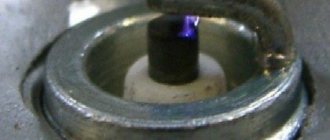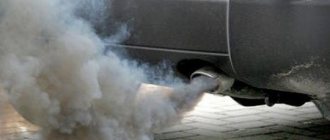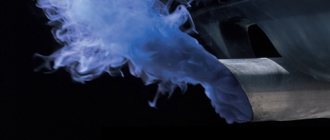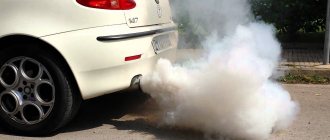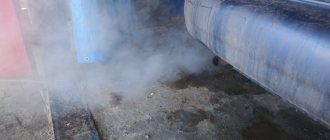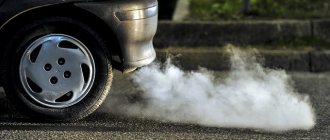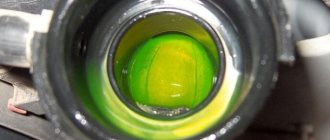Experienced motorists with extensive experience always closely monitor the exhaust pipe of their car - and for good reason. Sometimes condensation pours out of there, at other times soot particles fly out or a black coating appears on the edges of the pipe. This is a consequence of the processes occurring in the motor. Using these traces, you can determine the quality of the fuel poured, the condition of the catalyst, wear of the piston rings, and even the condition of the engine cooling system gaskets. All this will be useful for cars that have long expired their warranty period and can at any time upset the owners with expensive repairs. The sooner the driver diagnoses the problem, the less hassle he will have in the future.
How to detect soot in the muffler
It’s worth making a retreat right away; a small amount of soot in the muffler is acceptable. It can form over time. This soot is more like dust, and its layer can be easily removed, usually with a rag in one pass. However, if you see a build-up in the form of a black ring at the end of the pipe or a layer of soot in its inner part is more than 1 mm, there is most likely a malfunction in the engine.
This defect can be detected by simple visual inspection. For greater clarity, you can carefully run a wooden stick along the inner ring of the pipe. If soot covers the entire pipe, then it’s worth visiting a specialized service station to diagnose or repair the motor.
Often this phenomenon is discovered after refueling at unfamiliar gas stations. This does not greatly affect the driving performance of the car. There are no changes in dynamics or power. But soot appears in the pipe, and this is a bad sign.
What does car exhaust say?
The exhaust can be of different colors, sometimes if you notice smoke that is not typical for your car, you should think about it and check the condition of the power unit.
White exhaust may appear after the vehicle has been parked for a long time. This is due to condensation that accumulates in the exhaust system and begins to evaporate when the engine starts. The outside air temperature also affects the formation of white smoke. The colder it is, the more and longer the smoke comes out.
Therefore, in frosty weather, smoke can constantly come out. It's worse if white smoke comes out in warm weather. This may indicate that working fluid from the cooling system has entered the cylinder.
In this case, it is necessary to disassemble the engine, remove the cylinder head, change the cylinder head gasket, repair cracks, check the tightness of the head, and the like.
To check and confirm that liquid has entered the cylinders, you need to perform a number of actions:
- Start the engine, open the cap of the cooling system expansion tank and check for fluid bubbling. If bubbling is present, it means that gases are breaking into the cooling system. When the engine is turned off, the coolant level decreases, as part of it goes into the engine cylinders.
- You should pay attention to the color and condition of the liquid in the cooling system, the smell of burning, the presence of greasy stains on the surface, changes in color, density, etc. This may indicate microcracks and defects in the motor.
- It is necessary to check the oil level; there are often cases when it rises as a result of liquid from the cooling system entering it. As a result, the engine oil thins out and becomes cloudy, and an emulsion appears in it.
It is better not to use the engine until the problem is resolved, so as not to aggravate the situation. In the worst case, as a result of a large accumulation of fluid in the space above the piston, a hydraulic shock can occur, which will damage the power unit and lead to expensive repairs.
A gasoline engine usually produces black exhaust from the muffler when starting up; this occurs due to problems in the power system. In this case, the working mixture of fuel and air is greatly enriched, and more fuel enters the combustion chamber than necessary. The signs of this situation are as follows:
- Starting the engine is difficult;
- The spark plugs are filled with fuel;
- When starting, the power unit malfunctions and is not stable;
- Loud noise in the muffler operation, popping;
- High fuel consumption;
- The engine does not produce its former power;
- The on-board computer displays an error;
- Smell of gasoline when the unit is running
When the engine is running, the color may vary from gray to jet black. This is due to the fact that during operation a large amount of soot accumulates and over time it is released into the atmosphere.
There are many reasons that lead to fuel supply failure. You need to start looking for problems with the fuel supply systems. On carburetor engines, it is necessary to check the metering device, fuel and air jets, and the float chamber.
It is necessary to check the ignition system; it happens that when some element fails, such as the ignition coil, high-voltage wires, spark plugs, the engine as a whole fails.
It is necessary to check the condition of the air filter; if it is dirty, the mixture entering the cylinder will contain a lot of fuel.
In engines with injector, the electronic engine management system sometimes fails. By transmitting incorrect data to the control unit, the controller increases the fuel supply. Which in turn leads to an excess of the fuel mixture.
Also, the injectors in the engine can lose their tightness and pour fuel into the combustion chamber.
Filling spark plugs with fuel not only causes an excess of fuel, but also many other problems. For example, washing off the oil film from the cylinder walls, resulting in severe wear of the cylinders and piston group. In addition, a large amount of fuel enters the engine crankcase, which leads to oil dilution.
In any case, the motor needs to be fully checked, tuned and troubleshooted, otherwise the consequences will be very expensive.
Blue smoke when the engine is running indicates that engine oil is entering the combustion chamber.
Increased engine oil consumption will indicate that oil has entered the cylinder. Reasons for oil penetration:
- Severe wear of piston group parts;
- Damage to the gas distribution mechanism
When parts wear out, the piston rings fail, and defects appear on the piston and cylinder walls.
If the gas distribution mechanism breaks down, there is no seal in the area of the valve stem and valve guide.
For repairs, it will be necessary to replace the valve seals. Measure the compression in the engine. If the reduction in compression is insignificant, then as work progresses, the blue smoke disappears, since the gaps decrease when warmed up. If the gaps are large and the smoke does not stop, repairs must be made.
Why does soot occur?
The main reason is incomplete combustion of fuel in the engine. More precisely, the engine runs on a richer fuel mixture, as a result of which its complete combustion does not occur. Some of the gasoline burns outside the engine and the soot is not removed naturally, but remains in the exhaust system.
A rich mixture can form for several reasons:
- Due to poor quality fuel. Dilute gasoline does not have the desired detonation. For full operation of the engine, more fuel is required. Sensors that support the desired power parameters believe that the mixture needs to be enriched. The result is a larger volume of fuel, some of which is exhausted.
- Due to a malfunction of one or more sensors. Most often, a breakdown occurs in the lambda probe, which is responsible for supplying fuel to the engine.
- Due to incorrect or incorrect operation of the spark plugs. In this case, the fuel simply does not burn out from a bad spark.
- Due to a dirty air filter. The engine chokes, it requires more power, and more fuel enters the system.
However, the presence of black soot in the pipe does not always indicate a serious malfunction in the engine. Most often, such things can be fixed without repairing the internal combustion engine.
What does black smoke mean from the exhaust pipe of a gasoline engine?
Car muffler emissions poison the environment - this is a problem on a global scale. Manufacturers, caring about the environment, strive to purify exhaust to combine nitrogen with carbon dioxide and water vapor.
The ideal option is only possible if the power unit, ignition, fuel supply or cooling systems are in good working order. Black smoke from the exhaust pipe of a gasoline engine indicates a breakdown of the engine or auxiliary modules. Therefore, the appearance of a symptom requires inspection and repair of the vehicle’s chassis components.
Is the presence of black plaque always a sign of malfunction?
Black plaque is not always a wake-up call. Sometimes soot occurs due to an incorrectly tuned engine. For example, when the distributor in the car is set incorrectly, for later ignition. This drawback can be eliminated yourself by placing the distributor in a different position.
In some cases, you can simply try cleaning or replacing the spark plugs and changing the air filter.
Sometimes soot formation can occur when the car is parked for a long time and. In this case, the engine also runs on a richer mixture, which leads to the formation of a small amount of soot and is not a malfunction.
Shades of exhaust from cars with carburetor engines
Exhaust smoke from car models with carburetor engines can also have a white, black or bluish tint. They indicate the following malfunctions:
White smoke
White exhaust indicates that water has entered the Niva’s fuel mixture. This can occur as a result of condensation forming in the gas tank or fuel supply pipes, increased humidity during refueling of the vehicle, or water penetration from a damaged engine cooling system.
In addition, white exhaust occurs due to a violation of the tightness of the gaskets, refrigerant entering the engine cylinders, or water leakage in the heating system. In certain situations, white smoke is produced due to insufficient engine warm-up. When its temperature does not reach the required values, a certain amount of water remains in the exhaust system. For this reason, it is not advisable to make short trips in frosty weather.
Exhaust smoke has a bluish hue
Such exhaust can be formed due to oil entering the combustion chamber. This usually occurs due to significant wear of the cylinders and piston system. The degree of wear of the parts of these mechanisms can be determined by measuring the compression level. If this indicator corresponds to the established standard, then the cause of the bluish smoke may be damage to the seals, bushings and valve seals of the Niva.
Possible malfunctions that can cause the formation of bluish smoke also include a reduced degree of elasticity of rings, cuffs, bushings and valve plates, worn valve seats, and an increased oil level. Such smoke also appears due to the use of low-quality fuel with oil impurities.
Also interesting: Engine tuning: Niva 4x4 - increasing power using common methods || Boosting the Niva engine
Black exhaust
Black exhaust has a color that is given to it by soot, which is formed due to incomplete combustion of the fuel mixture.
This happens due to the supply of fuel that exceeds the norm of enrichment to the carburetor. Black exhaust also occurs when there is more fuel in the float chamber than normal. We can also identify such malfunctions as clogged holes, wear and damage to jets, a damaged air supply system damper, a faulty idle air valve, and low-quality spark plugs.
When determining the cause of the formation of Niva exhausts of a certain color and shade, you should remember that such exhausts can be caused by more than just one malfunction. This phenomenon can be a sign of several different damages and breakdowns at once, especially in old cars with worn out parts and mechanisms. However, in general, the above reasons for emissions will allow you to choose the right direction for troubleshooting and repair the Chevrolet Niva or another car in a timely manner.
In the video we'll see how to blow out the exhaust pipe to get rid of black exhaust once and for all.
How to check: is the appearance of soot caused by a malfunction or is this a normal condition?
The first thing to do is change the refueling location. You can also try using higher octane gasoline if your engine can handle it.
Most often, the reason lies precisely in low-quality fuel. In addition, you need to look at the condition of the spark plugs and air filter. If necessary, replace them too.
If these preventive actions do not produce results, it is worth stopping by a service station and checking the distributor and sensors responsible for fuel combustion in the engine.
Let's sum it up
So, to eliminate black, white, and blue smoke, sometimes it is enough to replace the filter and clean the injectors. Whereas in more serious cases it is necessary to repair the engine and its mechanisms.
It must be remembered that if the engine suddenly starts smoking black, you need to replace the fuel, since low-quality fuel, with a high content of additives and undesirable impurities, leads to a change in the color of the exhaust and difficulties in combustion of the mixture.
Do not forget that the timing belt must be installed according to the marks, the valves and valve timing must be clearly adjusted, the thermal clearance of the valves must be correctly installed. Spark plugs, during diagnostics, will help assess the condition of the engine.
The stability, reliability and durability of the power unit directly depends on everything, and many other indicators.
